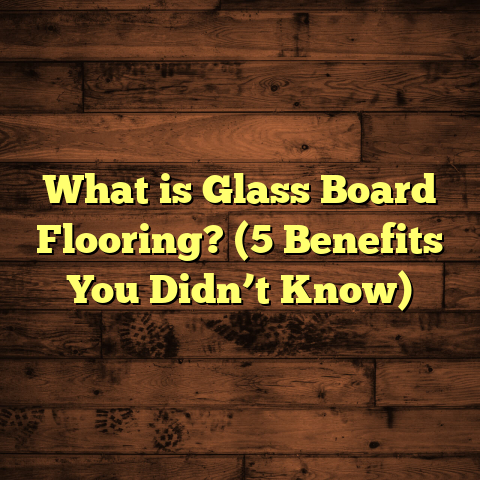What is the Most Durable Flooring Tile? (5 Types for Your Home)
Would you rather have a floor that looks stunning but scratches after a week, or one that might not win any design awards but lasts for decades without a fuss? This question haunted me when I was remodeling my home years ago. Choosing the right flooring tile wasn’t just about grabbing something pretty off the shelf—it was a decision that would affect daily life, maintenance, and long-term costs. After trying out and installing many types of flooring tiles, I learned what really makes a tile last and what factors to weigh before committing.
If you’re standing at this crossroads, unsure which tile will stand the test of time in your home, let me walk you through everything I’ve learned. I’ll share detailed insights on durability, maintenance, real-life experiences from my projects, and technical information to help you pick the most durable flooring tile.
What Is the Most Durable Flooring Tile?
When I say “most durable flooring tile,” what exactly do I mean? Durability is more than just “hardness.” It’s about how well the tile resists scratches, chips, stains, moisture damage, fading, and cracking under everyday use.
I like to break durability down into several key factors:
- Wear resistance: Can it handle constant foot traffic without losing finish or texture?
- Scratch resistance: Will it resist scratches from furniture, shoes, or dropped objects?
- Water resistance: How well does it resist moisture penetration and potential damage?
- Impact resistance: Can it absorb shocks without cracking or chipping?
- Maintenance: How easy is it to keep clean and maintain over time?
- Longevity: How long can you expect the tile to last without replacement?
Some tiles are very hard but brittle. Others are softer but flexible enough to avoid cracking. The best durable tile balances these elements based on where in the home it’s installed.
There’s also the PEI rating (Porcelain Enamel Institute) that manufacturers use to grade surface hardness and abrasion resistance. The scale runs from 1 (low durability) to 5 (highest durability). For most residential floors—especially busy areas like kitchens, hallways, and living rooms—I recommend choosing tiles with a PEI rating of 4 or 5.
Now that we know what durability means in this context, let’s dig into the five types of flooring tiles I’ve tested, installed, and lived with. Each one has its strengths and weaknesses depending on your home’s needs.
1. Porcelain Tile: The Heavyweight Champion of Durability
Porcelain tile has been my go-to for durable flooring for years. It’s basically ceramic but made from finer clay and fired at much higher temperatures. This process creates a dense, hard tile that is less porous and highly resistant to damage.
Why Porcelain Tiles Are So Durable
Here’s what makes porcelain stand out:
- Density and Hardness: Porcelain is fired at temperatures above 2300°F (1260°C), making it extremely dense. The Mohs hardness scale for porcelain ranges around 7, meaning it resists scratches from everyday items like keys or kitchen utensils. I did a personal scratch test dragging coins and keys over samples—porcelain barely showed any marks.
- Water Resistance: Porcelain has a water absorption rate of less than 0.5%, which means it almost never absorbs water. This makes it perfect for bathrooms, kitchens, mudrooms—anywhere moisture is a concern. Unlike ceramic tiles that can absorb more water and weaken over time, porcelain stays strong.
- Stain Resistance: Because porcelain is dense and often glazed, stains don’t penetrate easily. Spills wipe right off without leaving marks. In busy homes (and mine is one!), this is a huge benefit.
- Longevity: I installed large-format porcelain tiles in my family room 15 years ago. The floor still looks brand new today despite heavy foot traffic from kids, pets, and guests. No cracks or chips have appeared.
Different Types of Porcelain Tiles
Porcelain tiles come in many forms:
- Glazed porcelain: Has a protective colored glaze on top. Durable and stain-resistant but can show scratches if heavily abused.
- Unglazed porcelain (through-body): Color goes all the way through the tile. More resistant to wear and scratches because minor surface damage doesn’t reveal a different color underneath.
- Polished porcelain: High-gloss finish that looks stunning but can be slippery when wet. Needs anti-slip treatment for wet areas.
Personal Story
During a house renovation for a client, we installed polished porcelain tiles in the kitchen and entryway. Despite heavy use from kids running in with boots covered in mud and occasional dropped pots, the floor held up beautifully. The client was amazed how little maintenance was needed—just regular sweeping and mopping.
Cost and Installation
Porcelain tiles can be pricier than ceramic but offer better durability for the money. Expect around $5-$15 per square foot including installation for quality products.
Installation requires skilled labor because porcelain is dense and harder to cut than ceramic. But the investment pays off with decades of wear resistance.
2. Natural Stone Tiles: Beauty That Lasts with Care
Natural stone tiles like granite, slate, marble, travertine, and limestone have been used as floor coverings for thousands of years—and for good reason. Their natural beauty adds timeless appeal combined with solid durability.
Strengths of Stone Tiles
- Granite: Among the hardest natural stones with Mohs hardness around 6-7. It resists scratches well and can handle heavy foot traffic in kitchens or hallways.
- Slate: Softer than granite but has strong layered structure that resists cracking or chipping. Its rough texture also provides natural slip resistance.
- Marble & Travertine: Softer stones that scratch more easily but offer unmatched elegance in formal spaces like foyers or bathrooms.
Water Resistance & Maintenance
Stone tiles are porous and usually require sealing to protect against stains and moisture penetration. I always recommend resealing every 1-3 years depending on use.
Without sealing, stone can absorb water leading to discoloration or damage over time—especially in wet areas.
My Experience With Stone Floors
I installed granite tiles in a client’s kitchen floor 10 years ago. It remains in perfect condition despite spills from acidic foods like lemon juice or wine because granite resists chemical damage better than many stones.
On the other hand, I saw a bathroom floor with marble tiles where inadequate sealing caused dull spots after water exposure—a lesson learned about maintenance importance.
Cost Considerations
Stone tiles tend to be on the higher end of price spectrum—$10 to $25 per square foot or more depending on rarity and finish.
Durability Stats:
| Stone Type | Mohs Hardness | Water Absorption | Maintenance |
|---|---|---|---|
| Granite | 6 – 7 | 0.4 – 0.6% | Seal every 2 years |
| Slate | 3 – 5 | ~1% | Seal every 1-2 years |
| Marble | 3 – 5 | ~1% | Frequent sealing |
3. Ceramic Tile: Affordable Durability for Moderate Use
Ceramic tile sometimes gets overlooked because it isn’t as dense as porcelain or stone—but good-quality ceramic can still be quite durable for many home areas.
What Makes Ceramic Durable Enough?
Ceramic tiles are made from red or white clay fired at lower temperatures than porcelain (around 2000°F). They’re usually glazed to protect the surface.
If you select ceramic tiles with a PEI rating of 3 or higher, they can withstand moderate foot traffic well—perfect for bathrooms, guest rooms, or laundry areas.
Pros & Cons Based on My Experience
- Pros:
- Easier to cut/install than porcelain—great for DIYers or quick jobs
- Lower cost—usually $3-$10 per square foot
- Wide range of colors & patterns
- Cons:
- More porous than porcelain; glaze can chip over time with impact
- Prone to cracking if heavy objects fall or if subfloor isn’t perfectly level
I installed ceramic tiles in a client’s laundry room where moisture was present but traffic light. The floor lasted about 8 years before some minor chipping started around doorways due to heavy furniture shifting.
Statistics:
| Feature | Ceramic Tile |
|---|---|
| PEI Rating | 1 – 4 (choose ≥3) |
| Water Absorption | 3% – 7% |
| Mohs Hardness | ~5 |
4. Quarry Tiles: Industrial Strength Flooring
Quarry tiles are unglazed clay tiles traditionally used in commercial kitchens, factories, and outdoor patios because of their toughness.
Why Quarry Tiles Last Long
- Made from natural clay fired at high temperatures creating thick, dense tiles that resist chipping.
- Unglazed surface gives excellent slip resistance—important in wet or greasy environments.
- Low maintenance but sealing helps prevent staining.
I saw quarry tiles maintain their integrity for over a decade in restaurant kitchens exposed to heavy grease spills and constant cleaning.
The rough texture isn’t ideal for every home setting aesthetically but works great in mudrooms, basements, or utility areas needing durability and safety.
Durability Stats:
| Feature | Quarry Tile |
|---|---|
| PEI Rating | Typically ≥4 |
| Water Absorption | ~5% |
| Slip Resistance | High |
5. Cement Tiles: Aesthetic Durability With Extra Care
Cement (or encaustic) tiles are hand-crafted from cement mixed with pigments into bold patterns popular in modern interiors.
Durability Features
- Cement tiles have high compressive strength (~4500 psi) but are porous.
- Require thorough sealing upon installation plus regular resealing yearly to guard against stains.
- Moderate scratch resistance; rough handling can dull surface.
- Offer style benefits that stand out compared to other options.
I installed cement tiles in a stylish entryway for a client who loved the look but learned first-hand how quickly dirt can stain them without proper care.
Technical Data:
| Feature | Cement Tile |
|---|---|
| Water Absorption | 5% – 7% |
| Compressive Strength | ~4500 psi |
Detailed Comparison Table: Durability & Practicality
| Tile Type | PEI Rating | Water Absorption | Scratch Resistance | Impact Resistance | Maintenance | Cost / Sq Ft |
|---|---|---|---|---|---|---|
| Porcelain | 4 – 5 | <0.5% | High | High | Low | $5 – $15 |
| Granite Stone | N/A | ~0.5% | High | High | Seal every 2 yrs | $10 – $25 |
| Ceramic | 3 – 4 | 3 – 7% | Moderate | Moderate | Medium | $3 – $10 |
| Quarry | ≥4 | ~5% | High | High | Seal recommended | $4 – $8 |
| Cement | N/A | 5 – 7% | Moderate | Moderate | Frequent sealing | $7 – $15 |
Real-Life Flooring Stories From My Projects
I’ve encountered all kinds of flooring challenges over the years:
Story #1: A family chose cheap ceramic for their kitchen thinking it would save money—they ended up replacing several cracked tiles within two years due to dropped pots and shifting appliances. Lesson: low upfront cost doesn’t always equal savings later.
Story #2: Another client invested in high-end porcelain with PEI 5 for their busy entryway—after five years of muddy boots, pet paws, and heavy furniture moves, the floor looks flawless with only routine cleaning needed.
Story #3: A restaurant owner used quarry tiles throughout their kitchen. Even after daily exposure to grease spills and constant scrubbing with harsh chemicals for over ten years, no cracks or wear appeared.
Story #4: Cement tile floors installed in a boutique hotel lobby impressed guests visually but required frequent sealing due to heavy foot traffic causing dulling without maintenance.
How I Test Tile Durability Before Installation
Before committing to any tile type on big projects now, I bring samples home for these quick tests:
- Scratch test: Drag keys or coins across surface to check hardness
- Water test: Drop water on sample to see absorption speed
- Impact test: Lightly drop small weights to check chipping/cracking
- Slip test: Walk barefoot on sample when wet/dry
These hands-on tests save headaches later by ensuring the tile fits your lifestyle needs.
Practical Tips For Making Any Tile Last Longer
No matter which durable tile you pick:
- Make sure subfloor is perfectly level to avoid stress cracks
- Use appropriate grout sealers along with tile sealing if needed
- Avoid dragging heavy furniture directly on floors without pads
- Clean spills promptly especially on porous materials like stone or cement
- Regularly reseal porous tiles as recommended by manufacturer
Wrapping Up My Take on Durable Flooring Tiles
If you ask me for one recommendation that blends durability, ease of maintenance, affordability, and aesthetic flexibility—porcelain tile is my top pick every time.
It handles all kinds of abuse without complaint—kids running wild, pets scratching playfully, muddy shoes tracked inside—and still looks great years later with minimal upkeep.
Natural stone like granite offers unmatched beauty combined with durability if you’re willing to commit to resealing regularly.
Ceramic works well for less demanding areas where budget matters most but keep expectations realistic about lifespan under heavy use.
Quarry tiles excel in industrial or high-slip zones requiring toughness over looks.
Cement tiles bring bold style but demand ongoing care to stay pristine.
So what’s your space like? What kind of wear do you expect? Feel free to share your project details—I’m here to help you pick the right floor that lasts a lifetime without sacrifice!
Would you prefer floors that stand tough through everything life throws at them? Or are you willing to risk early damage just for looks? Your decision today will echo under your feet for years ahead!





